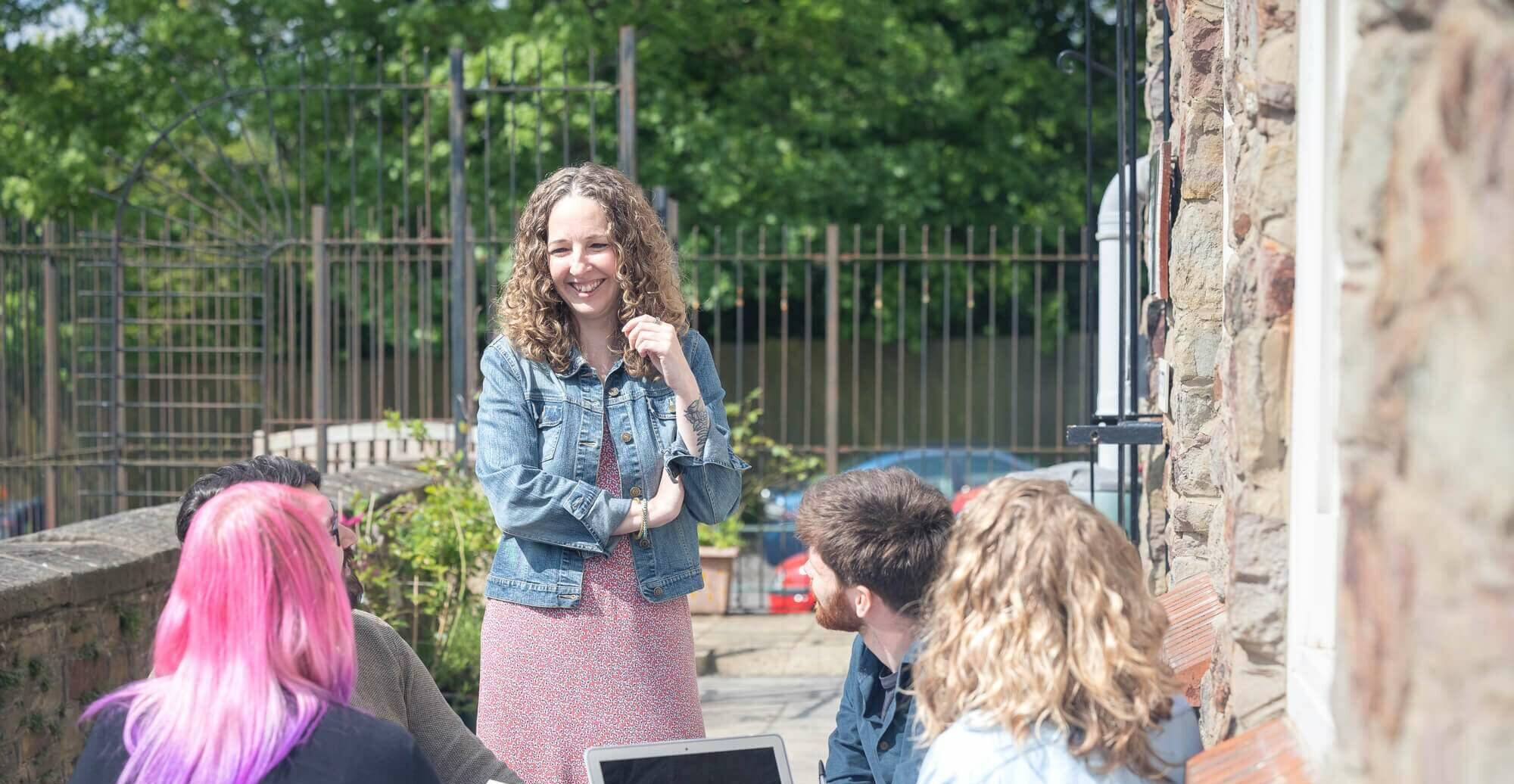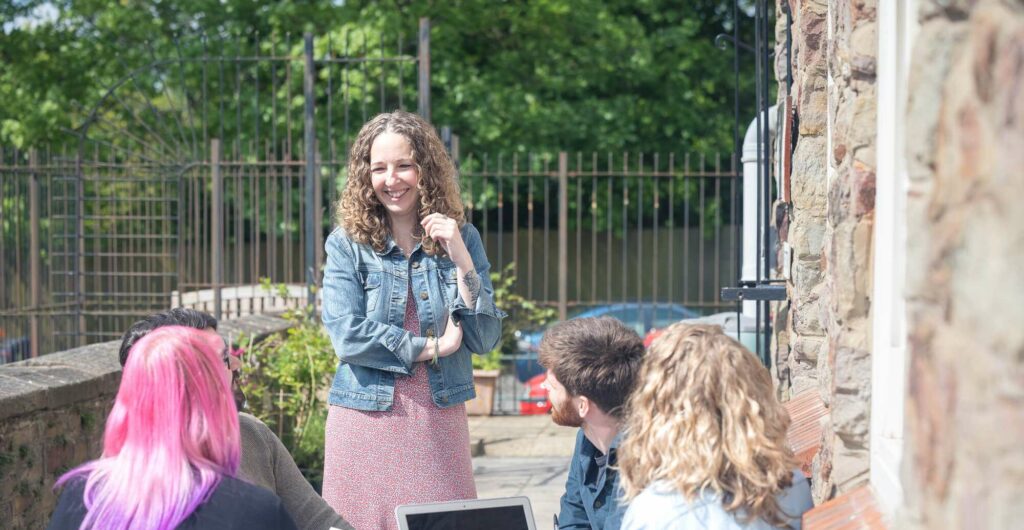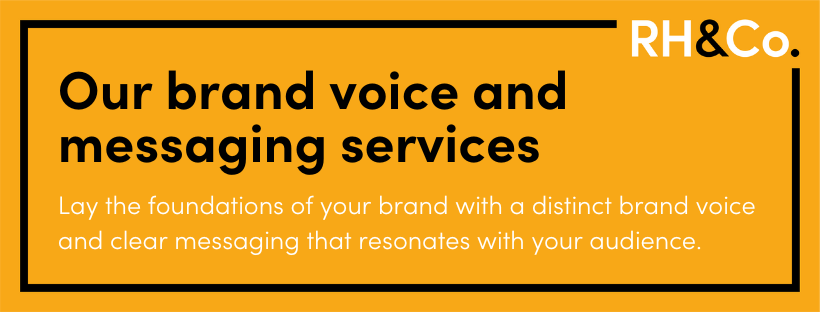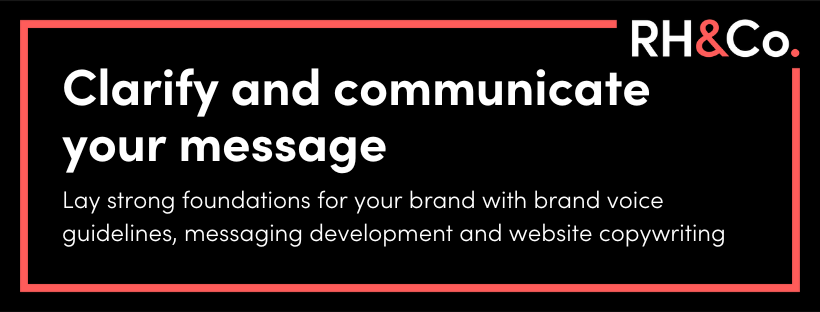

Is your B2B brand voice “friendly but professional”?
Every time someone in B2B describes their brand voice as “friendly but professional” we try not to sigh. Unfortunately, you could be describing virtually every B2B business in the world. No one wants to come across as unfriendly or unprofessional, right?
If you try to adopt a friendly but professional tone, your brand will usually slip into whatever the default tone is in your industry. If you run a creative agency, you’ll seem like all the other agencies. If you’re a hot new startup, you’ll sound like every other new tech company in town.
There’s really no good reason why companies should sound the same. The average native speaker has 15-20,000 root words in their active vocabulary. There’s plenty of potential for variety – why do we keep defaulting to terms like ‘transform’ or ‘unlock value’? And why, why, why do articles keep starting with the phrase ‘In our fast-paced digital world…’ ?
Even in B2B, you want to differentiate your brand from the competition. And you need to create an instant connection with your audience. If you take a backseat on brand voice, you’ll be skipping over one of your primary ways you build your brand’s success.
TL:DR
- What is brand voice?
- What can brand voice really achieve?
- How to develop your organisation’s brand voice
- How to create practical guidelines for your brand voice
What is brand voice?
Brand voice is how an organisation’s words convey brand personality. It covers both what you say and how you say it, and is influenced by everything from sentence length to individual word choice, and the use of active or passive voice.
Brand voice can literally be as nitpicking as whether or not you use contractions (can’t, I’ve, they’re). We wrote the website copy for a law firm once and they insisted that there were no contractions anywhere, which resulted in them coming across as extremely formal and businesslike rather than warm. That’s not necessarily a bad thing, it’s just important to be aware that the language you use will impact how people perceive your brand.
It’s like meeting a person for the first time. Initially, your impression will be based on how they look, how they’re dressed and presented, their facial expression, how they catch your eye, etc. This is the equivalent of brand visuals.
Once they start talking to you, you’ll have much more to go on – not just what they say but how they say it – their accent, pitch and the pace at which they speak. You might conclude that they’re warm, well educated, no-nonsense, boring, try-hard, trendy, quick-witted or uptight. Your potential clients will judge you by your brand voice in the same way.
…their brand was a lot like Stephen Fry – intelligent and knowledgeable about all sorts of things but also lightly funny and humble and very real, appealing to people of all backgrounds and ages.

What can brand voice really achieve?
Pitched right, your brand voice can express your attitudes and values, build your reputation, and even attract your ideal clients. That’s no exaggeration. If your brand voice is distinct from the tone your competitors use, or it helps express old concepts in a refreshingly new way, there’s no reason it can’t be a big part of your brand strategy.
For instance, one of our fintech clients, Weavr, works in an incredibly complex field: embedded finance. In general, this market adopts a hyped up, tech normative voice (using words like innovative, transform, optimise, evolve, disrupt, supercharge, etc. etc.) or an academic one (think McKinsey).
After a workshop with our client’s commercial team, we suggested that they opt for a different tone entirely: that of a popular, cool, research professor who works alongside their students and demystifies complex concepts for them. The result was a voice that was clever but not too academic. Confident but not hyped-up and salesy. Really relatable but not gimmicky.
As you can see, this voice is much more developed than “friendly but professional” and it gave our client some really practical guidance. Rather than they could talk about making B2B transactions as “easy as ApplePay”. Their voice even guided some of their content strategy, such as the creation of a buyer’s guide that demystified an area that is rarely explained in their field – making the brand totally distinct from the competition.
How to develop your organisation’s brand voice
The best way to understand brand voice in context is to think about a conversation between two people – your brand and your client.
1. Start with who you are
First, you’ll want to create your brand avatar or persona. This is who your organisation would be if it was a person. A helpful starting point is to identify which of Carl Jung’s 12 personality archetypes fit your brand best.
Creating a brand avatar is an exercise best done with more than one person – often the business founder and/or the marketing lead at the very least, and ideally a representative from sales too. Really, you want the whole leadership team involved, at least in the initial brainstorming stages.
Together, discuss who your brand would be if they were sitting in the room with you. Would they be young or old? How would they be dressed? What values would they express?
If the concept still feels too abstract, try thinking about which celebrity your brand might be like. Years ago we did some training with a South West tourism organisation. During a brand voice session we suggested that their brand was a lot like Stephen Fry – intelligent and knowledgeable about all sorts of things but also lightly funny and humble and very real, appealing to people of all backgrounds and ages.
Some of your choices will be dictated by what you stand for. For instance, when we were helping to shape the brand voice of Nviro, specialist cleaning provider, we saw they wanted to change the culture surrounding the cleaning profession – celebrating cleaners and putting dignity before profit.
For Nviro, it was vital that they made no hierarchical distinction between their office team and their frontline cleaners. Also the word ‘staff’ would be completely off limits. The same went for any term that suggested Nviro were trying to avoid the word cleaner (like cleaning operative, or cleaning technician). In this team, there was no embarrassment or misgivings about the profession. They were cleaners. And they were proud of it.

2. Think about your audience
As a B2B brand you may think you’re marketing to businesses rather than people, but ultimately even the biggest corporate deal is made by real people. From the gatekeeper to the person approving the purchase order, it’s important that you understand what they need to hear from your brand.
Are they more motivated by targets and goals, or are they a person with a dream or a vision? Are they disillusioned or are they optimistic? Are they interested in technical detail or do they want concepts to be explained without it? Are they in a mood for humour? Or are they looking for reassurance?
One of our fintech clients, Moneyhub, was creating a product for an audience of lenders. Its personas were typically experts in the financial industry, but potentially distrustful of tech companies.
As a result, we recommended Moneyhub choose a voice that included technical financial terms – such as delinquency, manageable risk, etc. – but didn’t slip into techy language – unlock opportunities with the power of data, etc. – which could have alienated the brand from its ideal clientele.
3. Think about your competition
The trouble is, in this conversation, you might not be the only ones in the room. Your audience might be scouting out their options, and they could even already be in talks with a competitor. You need to make sure you sound like a real alternative, and not just more of the same.
When we were working with TPC Leadership to develop their brand voice, we had a challenge on our hands. The global company works in leadership development and cultural change, and if you’re familiar with the industry, you’ll know almost everyone in it sounds alike.
That’s partly because coaches and consultants are selling an intangible offering – and it’s very easy to reach for the same intangible words to describe it: ‘a transformational programme’ or a ‘people-centred approach.’
To make TPCL stand out, we suggested they don’t try to distinguish themselves by their offering and philosophy, but by making it clear what they stand for in bold and concrete terms. As a result, if you head to their new website, you’ll quickly see what they’re about.
Here’s an exercise: go back through the content you’ve produced, any pages on your website, posts on your social channel, or talks given by your CEO or managing director. Then try and pull out phrases that could have only come from your brand and not your competitors.
How to create practical guidelines for your brand voice
Now it’s time to pull these ideas together to create guidelines that everyone who writes on behalf of the brand – both internally and externally (PR agency, marketing agency etc) can follow. This will ensure you get that level of consistency you need to build trust and client loyalty.
Writing brand voice guidelines is a task best left to your marketing lead, or a brand or copywriting agency. It doesn’t matter how your guide is actually formatted, but you want to end up with a document that translates the ideas you’ve had about how your brand should come across into a guide that anyone can follow to produce content that fits.
If the task of creating brand voice guidelines falls to you, make sure you include a concise overview of your client and brand personas. Have a summary of your brand offerings, your values and what makes you distinct from your competitors.
Then spend time creating a style guide and some helpful examples – words and phrases to use or avoid, some sentences written in your brand voice and some in a way that wouldn’t be acceptable, so people can see the difference.
Back to hompeage









